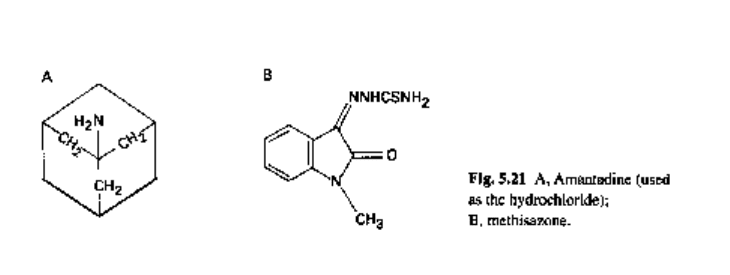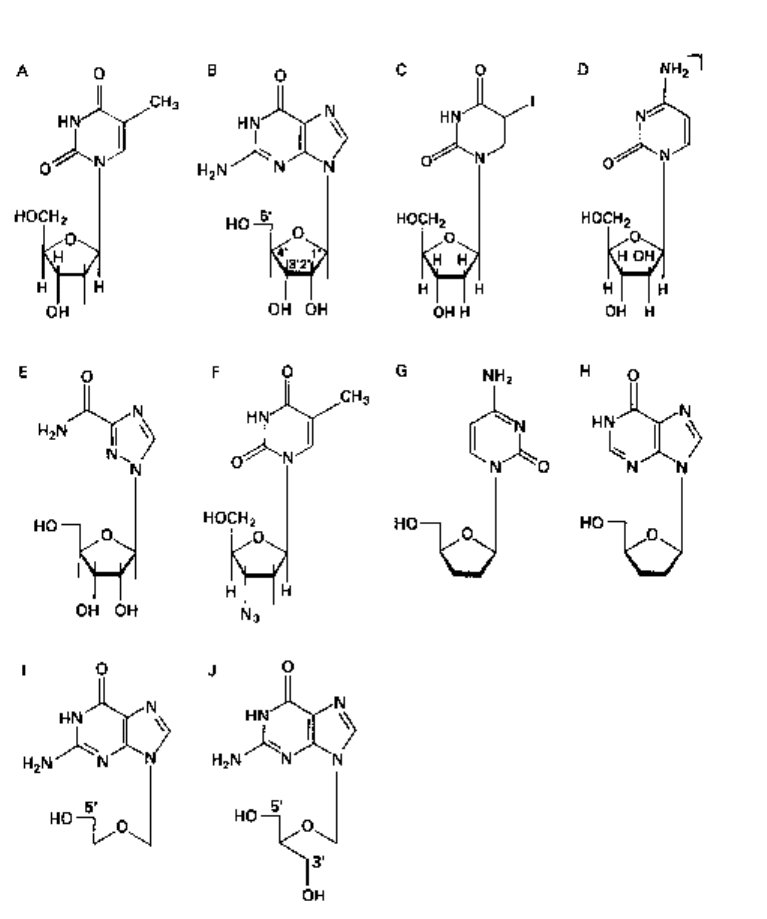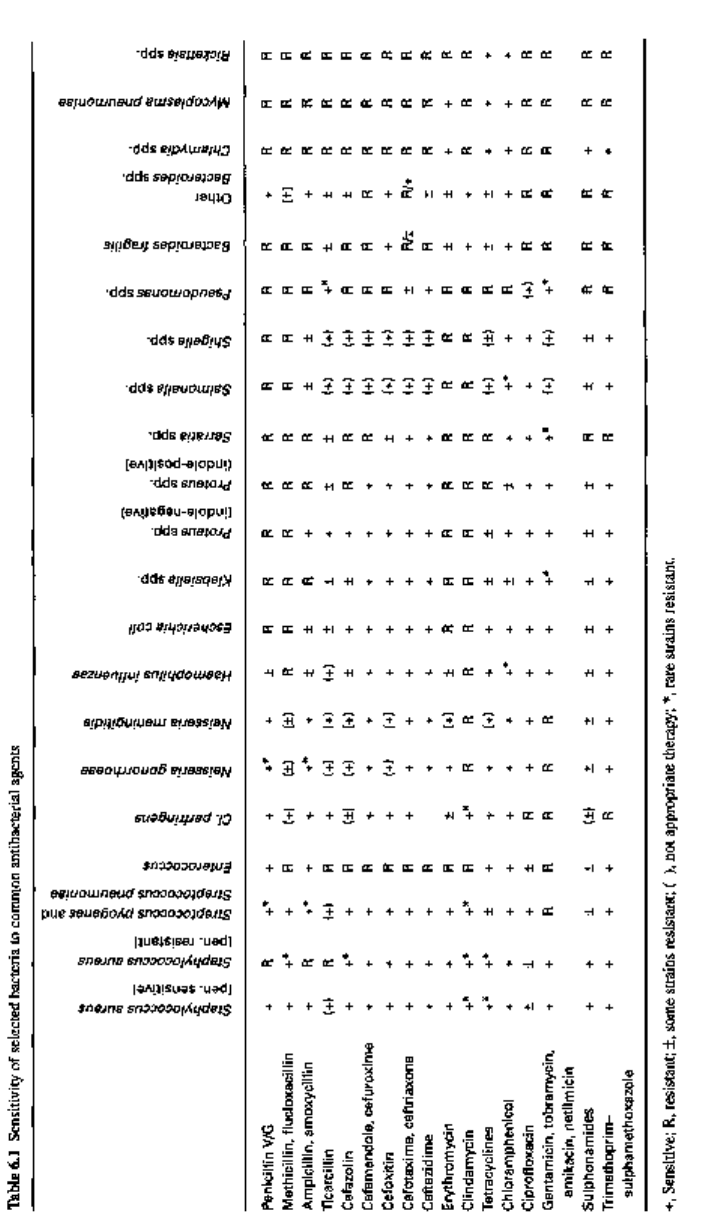Hugo W.B., Russel A.D.(ed). Pharmaceutical Microbiology
Подождите немного. Документ загружается.


12.2
Methisazone
Methisazone (Fig. 5.2IB) inhibits DNA viruses (particularly vaccinia and variola) but
not RNA viruses, and has been used in the prophylaxis of smallpox. It is now little
used, especially as, according to the World Health Organization, smallpox has now
been eradicated.
12.3
Nucleoside analogues
Various nucleoside analogues have been developed that inhibit nucleic acid synthesis.
Idoxuridine (2'-deoxy-5-iodouridine; IUdR; Fig. 5.22C) is a thymidine analogue
which inhibits the utilization of thymidine (Fig. 5.22A) in the rapid synthesis of DNA
that normally occurs in herpes-infected cells. Unfortunately, because of its toxicity,
idoxuridine is unsuitable for systemic use and it is restricted to topical treatment of
herpes-infected eyes. Other nucleoside analogues include the following: cytarabine
(cytosine arabinoside; Ara-C; Fig. 5.22D) which has antineoplastic and antiviral
properties and which has been employed topically to treat herpes keratitis resistant
to idoxuridine; adenosine arabinoside (Ara-A; vidarabine); and ribavirin (1-/3-D-
ribofuranosyl-l,2,4-triazole-3, carboxamide; Fig. 5.22E) which has a broad spectrum
of activity, inhibiting both RNA and DNA viruses. Vidarabine, in particular, has a high
degree of selectivity against viral DNA replication and is primarily active against
herpesviruses and some poxviruses. It may be used systemically or topically. It is related
structurally to guanosine (Fig. 5.22B).
Human immunodeficiency virus (HIV) is a retrovirus, i.e. its RNA is converted in
human cells by the enzyme reverse transcriptase to DNA which is incorporated into the
human genome and is responsible for producing new HIV particles. Zidovudine
(azidothymidine, AZT; Fig. 5.22F) is a structural analogue of thymidine (Fig. 5.22A)
and is used to treat AIDS patients. Zidovudine is converted in both infected and
uninfected cells to the mono-, di- and eventually triphosphate derivatives. Zidovudine
triphosphate, the active form, is a potent inhibitor of HIV replication, being mis-
taken for thymidine by reverse transcriptase. Premature chain termination of viral
DNA ensues. However, AZT is relatively toxic because, as pointed out above, it
is converted to the triphosphate by cellular enzymes and is thus also activated in
uninfected cells.
2'3'-Dideoxycytidine (DDC, zalcitabine), a nucleoside analogue that also inhibits
reverse transcriptase, is more active than zidovudine in vitro, and (unlike zidovudine)
does not suppress erythropoiesis. DDC is not without toxicity, however, and a
severe peripheral neurotoxicity, which is dose-related, has been reported. The chemical
Types of antibiotics 125

Fig. 5.22 Thymidine (A), guanosine (B) and some nucleoside analogues (C-J). C, idoxuridine;
D, cytarabine; E, ribavirin; F, zidovudine (AZT); G, dideoxycytidine (DDC); H, dideoxyinosine
(DDI); I, acyclovir; J, ganciclovir.
structures of DDC and of another analogue with similar properties, 2'3'-dideoxyinosine
(DDI, didanosine), are presented in Fig. 5.22 (G, H, respectively).
Acyclovir (acycloguanosine, Fig. 5.221) is a novel type of nucleoside analogue
which becomes activated only in herpes-infected host cells by a herpes-specific
enzyme, thymidine kinase. This enzyme initiates conversion of acyclovir initially to a
monophosphate and then to the antiviral triphosphate which inhibits viral DNA
polymerase. The host cell polymerase is not inhibited to the same extent, and the antiviral
triphosphate is not produced in uninfected cells. Ganciclovir (Fig. 5.22J) is up to 100
126 Chapters

12.4
times more active than acyclovir against human cytomegalovirus (CMV) but is also
much more toxic; it is reserved for the treatment of severe CMV in immunocompromised
patients. Famciclovir is similar, and valociclovir is a pro-drug ester of acyclovir.
Non-nucleoside compounds
Apart from the amantadines (section 12.1) and methisazone (section 12.2), various
non-nucleoside drugs have shown antiviral activity. Two simple molecules with potent
activity are phosphonoacetic acid (Fig. 5.23A) and sodium phosphonoformate (foscarnet,
Fig. 5.23B). Phosphonoacetic acid has a high specificity for herpes simplex DNA
synthesis, and has been shown to be non-mutagenic in experimental animals, but is
highly toxic. Foscarnet inhibits herpes DNA polymerase and is non-toxic when applied
to the skin and is a potentially useful agent in treating herpes simplex labialis (cold
sores). It is used for cytomegalovirus retinitis in patients with AIDS in whom ganciclovir
is inappropriate. Tetrahydroimidazobenzodiazepinone (TIBO) compounds have shown
excellent activity in vitro against HIV reverse transcriptase in HIV type 1 (HIV-1) but
not HIV-2 or other retroviruses.
Reverse transcriptase inhibitors prevent DNA from being produced in newly infected
cells. They do not, however, prevent the reactivation of HIV from previously infected
cells, the reason being that the enzyme is not involved in this process. Thus, agents that
act at a later point in the replication cycle, possibly preventing reactivation, would be a
major advance in the treatment of AIDs sufferers. The HIV protease inhibitors, which
are currently receiving considerable attention, are believed to act in the manner depicted
in Fig. 5.24.
3Na
4
A 0 B
HO— P— CH
2
COOH
OH
Fig. 5.23 A, phosphonoacetic acid; B, sodium phosphonoformate (foscarnet).
-
0
p c
| \
o- 0"
Reverse
HIV RNA • HIV DNA
transcriptase
Incorporated into
host DNA (LATENT)
Protease inhibitors?
Reactivated
Fig. 5.24 Postulated mechanism of action of HIV protease inhibitors.
Types of antibiotics 127
12.5
Interferons
Interferon is a low molecular weight protein, produced by virus-infected cells, that
itself induces the formation of a second protein inhibiting the transcription of viral
mRNA. Interferon is produced by the host cell in response to the virus particle, the
viral nucleic and non-viral agents, including synthetic polynucleides such as polyinosinic
acid: polycytidylic acid (poly I: C). There are two types of interferon.
Type I interferons. These are acid-stable and comprise two major classes, leucocyte
interferon (Le-IFN, IFN-a) released by stimulated leucocytes, and fibroblast
interferon (F-IFN, IFN-/3) released by stimulated fibroblasts.
Type II interferons. These are acid-labile and are also known as 'immune' (IFN-y)
interferons because they are produced by T-lymphocytes (see Chapter 14) in the
cellular immune system in response to specific antigens.
Type I interferons induce a virus-resistant state in human cells, whereas Type II are
more active in inhibiting growth of tumour cells.
Disappointingly low yields of F-IFN and Le-IFN are achieved from eukaryotic
cells. Recently, however, recombinant DNA technology has been employed to produce
interferon in prokaryotic cells (bacteria). This aspect is considered in more detail in
Chapter 24.
13 Drug combinations
A combination of two antibacterial agents may produce the following responses.
1 Synergism, where the joint effect is greater than the sum of the effects of each drug
acting alone.
2 Additive effect, in which the combined effect is equal to the arithmetic sum of the
effects of the two individual agents.
3 Antagonism (interference), in which there is a lesser effect of the mixture than that
of the more potent drug action alone.
There are four possible justifications as to the use of antibacterial agents in
combination.
1 The concept of clinical synergism, which may be extremely difficult to demonstrate
convincingly. Even with trimethoprim plus sulphamethoxazole, where true synergism
occurs in vitro, the optimum ratio of the two components may not always be present in
vivo, i.e. at the site of infection in a particular tissue.
2 A wider spectrum of cover may be obtained, which may be (a) desirable as an
emergency measure in life-threatening situations; or (b) of use in treating mixed
infections.
3 The emergence of resistant organisms may be prevented. A classical example here
occurs in combined antitubercular therapy (see earlier).
4 A possible reduction in dosage of a toxic drug may be achieved.
Indications for combined therapy are now considered to be much fewer than
originally thought. There is also the problem of a chemical or physical incompatibility
between two drugs. Examples where combinations have an important role to play in
antibacterial chemotherapy were provided earlier (sections 2.3 and 2.9) in which a fi-
lactamase inhibitor and an appropriate j3-lactamase-labile penicillin form a single
128 Chapter 5
pharmaceutical product. It must also be noted that a combination of two /3-lactams
does not necessarily produce a synergistic effect. Some antibiotics are excellent inducers
of /3-lactamase, and consequently a reduced response (antagonism) may be produced.
14 Further reading
Bean B. (1992) Antiviral therapy: current concepts and practices. Clin Microbiol Rev, 5, 146-182.
Bowden K., Harris N.V. & Watson C.A. (1993) Structure-activity relationships of dihydrofolate reductase
inhibitors. / Chemother, 5, 377-388.
Bugg C.E., Carson W.M. & Montgomery J.A. (1993) Drugs by design. SciAm, 269, 92-98.
British National Formulary. London: British Medical Association & The Pharmaceutical Press. (The
chapter on drugs used in the treatment of infections is a particularly useful section. New editions of
the BNF appear at regular intervals.)
Brown A.G. (1981) New naturally occurring /J-lactam antibiotics and related compounds. J Antimicrob
Chemother, 7, 15-48.
Chopra I., Hawkey P.M. & Hinton M. (1992) Tetracyclines, molecular and clinical aspects. J Antimicrob
Chemother, 29, 245-277.
Greenwood D. (ed.) (1989) Antimicrobial Chemotherapy, 2nd end. London: Bailliere Tindall.
Hamilton-Miller J.M.T. (1991) From foreign pharmacopoeias: 'new' antibiotics from old? J Antimicrob
Chemother, 27, 702-705.
Hooper D.C. & Wolfson J.S. (eds) (1993) Quinolone Antimicrobial Agents, 2nd edn. Washington:
American Society for Microbiology.
Hunter PA., Darby G.K. & Russell N.J. (eds) (1995) Fifty Years of Antimicrobials: Past Perspectives
and Future Trends. 53rd Symposium of the Society for General Microbiology. Cambridge:
Cambridge University Press.
Kuntz I.D. (1992) Structure-based strategies for drug design and discovery. Science, 257, 1079-1082.
Lambert H.P, O'Grady F., Greenwood D. & Finch R.G. (1992) Antibiotic and Chemotherapy, 7th edn.
London & Edinburgh: Churchill Livingstone.
Neu H.C. (1985) Relation of structural properties of /^-lactam antibiotics to antibacterial activity. Am J
Med, 79 (Suppl. 2A), 2-13.
Power E.G.M. & Russell A.D. (1998) Design of antimicrobial chemotherapeutic agents. In: Introduction
to Principles of Drug Design (ed. H.J. Smith), 3rd edn, Bristol: Wright.
Reeves D.S. & Howard A.J. (eds) (1991) New macrolides—the respiratory antibiotics for the 1990s. J
Hosp Infect, 19 (Suppl. A).
Russell A.D. & Chopra I. (1996) Understanding Antibacteral Action and Resistance, 2nd edn. Chichester:
Ellis Horwood.
Sammes PG. (Ed.) Topics in Antibiotic Chemistry, vols 1-5. Chichester: Ellis Horwood.
Shanson D.C. (1989) Microbiology in Clinical Practice, 2nd edn. London: Wright.
Wolinski E. (1992) Antimycobacterial drugs. In: Infections Diseases (eds A. Gorbach, J.G. Bartlett &
N.R. Blacklow), pp. 319-319. Philadelphia: W.B. Saunders.
Wood M.J. (1991) More macrolides. Br Med J, 303, 594-595.
Types of antibiotics 129
Clinical uses of antimicrobial drugs
1
2
2.1
2.2
2.3
2.4
2.4.1
2.5
2.6
2.7
2.8
3
3.1
3.1.1
Introduction
Principles of use of antimicrobial drugs
Susceptibility of infecting organisms
Host factors
Pharmacological factors
Drug resistance
Multi-drug resistance
Drug combinations
Adverse reactions
Superinfection
Chemoprophylaxis
Clinical use
Respiratory tract infections
Upper respiratory tract infections
3.1.2
3.2
3.2.1
3.2.2
3.3
3.4
3.5
4
4.1
4.2
4.2.1
4.2.2
4.2.3
5
Lower respiratory tract infections
Urinary tract infections
Pathogenesis
Drug therapy
Gastrointestinal infections
Skin and soft tissue infections
Central nervous system infections
Antibiotic policies
Rationale
Types of antibiotic policies
Free prescribing policy
Restricted reporting
Restricted dispensing
Further reading
Introduction
The worldwide use of antimicrobial drugs continues to rise; in 1995 these agents
accounted for an expenditure of approximately £17000 billion. In the UK antibiotic
prescribing continues to rise. General practice use accounts for approximately 90% of
all antibiotic prescribing and largely involves oral and topical agents. Hospital use
accounts for the remaining 10% of antibiotic prescribing with a much heavier use of
injectable agents. Although this chapter is concerned with the clinical use of
antimicrobial drugs, it should be remembered that these agents are also extensively
used in veterinary practice as well as in animal husbandry as growth promoters. In
humans the therapeutic use of anti-infectives has revolutionized the management of
most bacterial infections, many parasitic and fungal diseases and, with the availability
of acyclovir and zidovudine (azidothymidine, AZT) (see Chapter 3 and 5), selected
herpesvirus infections and human immunodeficiency virus (HIV) infection, respectively.
Although originally used for the treatment of established bacterial infections, antibiotics
have proved useful in the prevention of infection in various high-risk circumstances;
this applies especially to patients undergoing various surgical procedures where peri-
operative antibiotics have significantly reduced postoperative infectious complications.
The advantages of effective antimicrobial chemotherapy are self-evident, but this
has led to a significant problem in ensuring that they are always appropriately used.
Surveys of antibiotic use have demonstrated that more than 50% of antibiotic prescribing
can be inappropriate; this may reflect prescribing in situations where antibiotics are
either ineffective, such as viral infections, or that the selected agent, its dose, route of
administration or duration of use are inappropriate. Of particular concern is the prolonged
use of antibiotics for surgical prophylaxis. Apart from being wasteful of health resources,
6
prolonged use encourages superinfection by drug-resistant organisms and unnecessarily
increases the risk of adverse drug reactions. Thus, it is essential that the clinical use of
these agents be based on a clear understanding of the principles that have evolved to
ensure safe, yet effective, prescribing.
Further information about the properties of antimicrobial agents described in this
chapter can be found in Chapter 5.
Principles of use of antimicrobial drugs
Susceptibility of infecting organisms
Drug selection should be based on knowledge of its activity against infecting
microorganisms. Selected organisms may be predictably susceptible to a particular
agent, and laboratory testing is therefore rarely performed. For example, Streptococcus
pyogenes is uniformly sensitive to penicillin. In contrast, the susceptibility of many
Gram-negative enteric bacteria is less predictable and laboratory guidance is essential
for safe prescribing. The susceptibility of common bacterial pathogens and widely
prescribed antibiotics is summarized in Table 6.1. It can be seen that, although certain
bacteria are susceptible in vitro to a particular agent, use of that drug may be
inappropriate, either on pharmacological grounds or because other less toxic agents
are preferred.
Host factors
In vitro susceptibility testing does not always predict clinical outcome. Host factors
play an important part in determining outcome and this applies particularly to circulating
and tissue phagocytic activity. Infections can progress rapidly in patients suffering
from either an absolute or functional deficiency of phagocytic cells. This applies
particularly to those suffering from various haematological malignancies, such as the
acute leukaemias, where phagocyte function is impaired both by the disease and also
by the use of potent cytotoxic drugs which destroy healthy, as well as malignant, white
cells. Under these circumstances it is essential to select agents which are bactericidal,
since bacteristatic drugs, such as the tetracyclines or sulphonamides, rely on host
phagocytic activity to clear bacteria. Widely used bactericidal agents include the
aminoglycosides, broad-spectrum penicillins, the cephalosporins and quinolones (see
Chapter 5).
In some infections the pathogenic organisms are located intracellularly within
phagocytic cells and, therefore, remain relatively protected from drugs which penetrate
cells poorly, such as the penicillins and cephalosporins. In contrast, erythromycin,
rifampicin and chloramphenicol readily penetrate phagocytic cells. Legionnaires' disease
is an example of an intracellular infection and is treated with rifampicin and/or
erythromycin.
Pharmacological factors
Clinical efficacy is also dependent on achieving satisfactory drug concentrations at the
Clinical uses of antimicrobial drugs 131

site of the infection; this is influenced by the standard pharmacological factors of
absorption, distribution, metabolism and excretion. If an oral agent is selected,
gastrointestinal absorption should be satisfactory. However, it may be impaired by
factors such as the presence of food, drug interactions (including chelation), or impaired
gastrointestinal function either as a result of surgical resection or malabsorptive states.
Although effective, oral absorption may be inappropriate in patients who are vomiting
or have undergone recent surgery; under these circumstances a parenteral agent will be
required and has the advantage of providing rapidly effective drag concentrations.
Antibiotic selection also varies according to the anatomical site of infection. Lipid
solubility is of importance in relation to drug distribution. For example, the amino-
glycosides are poorly lipid-soluble and although achieving therapeutic concentrations
within the extracellular fluid compartment, penetrate the cerebrospinal fluid (CSF)
poorly. Likewise the presence of inflammation may affect drug penetration into the
tissues. In the presence of meningeal inflammation, /3-lactam agents achieve satisfactory
concentrations within the CSF, but as the inflammatory response subsides drug
concentrations fall. Hence it is essential to maintain sufficient dosaging throughout the
treatment of bacterial meningitis. Other agents such as chloramphenicol are little affected
by the presence or absence of meningeal inflammation.
Therapeutic drug concentrations within the bile duct and gall bladder are dependent
upon biliary excretion. In the presence of biliary disease, such as gallstones or chronic
inflammation, the drug concentration may fail to reach therapeutic levels. In contrast,
drugs which are excreted primarily via the liver or kidneys may require reduced dosaging
in the presence of impaired renal or hepatic function. The malfunction of excretory
organs may not only risk toxicity from drug accumulation, but will also reduce urinary
concentration of drags excreted primarily by glomerular filtration. This applies to the
aminoglycosides and the urinary antiseptics, nalidixic acid and nitrofurantoin, where
therapeutic failure of urinary tract infections may complicate severe renal failure.
2.4 Drug resistance
Drag resistance may be a natural or an acquired characteristic of a microorganism.
This may result from impaired cell wall or cell envelope penetration, enzymatic
inactivation or altered binding sites. Acquired drug resistance may result from mutation,
adaptation or gene transfer. Spontaneous mutations occur at low frequency, as in the
case of Mycobacterium tuberculosis where a minority population of organisms is
resistant to isoniazid. In this situation the use of isoniazid alone will eventually result
in overgrowth by this subpopulation of resistant organisms.
A more recently recognized mechanism of drug resistance is that of efflux in which
the antibiotic is rapidly extruded from the cell by an energy-dependent mechanism.
This affects antibiotics such as the tetracyclines and macrolides.
Genetic resistance may be chromosomally or plasmid-mediated. Plasmid-mediated
resistance has been increasingly recognized among Gram-negative enteric pathogens.
By the process of conjugation (Chapter 9), resistance plasmids may be transferred
between bacteria of the same and different species and also different genera. Such
resistance can code for multiple antibiotic resistance. For example, the penicillins,
cephalosporins, chloramphenicol and the aminoglycosides are all subject to enzymatic
Clinical uses of antimicrobial drugs 133
inactivation which may be plasmid-mediated. Knowledge of the local epidemiology of
resistant pathogens within a hospital, and especially within high-dependency areas
such as intensive care units, is invaluable in guiding appropriate drug selection.
2.4.1 Multi-drug resistance
In recent years multi-drug resistance has increased among certain pathogens. These
include Staph, aureus, enterococci and M. tuberculosis. Staphylococcus aureus resistant
to methicillin is known as methicillin-resistant Staph, aureus (MRSA). These strains
are resistant to many antibiotics and have been responsible for major epidemics
worldwide, usually in hospitals where they affect patients in high-dependency units
such as intensive care units, burns units and cardiothoracic units. MRSA have the ability
to colonize staff and patients and to spread readily among them. Several epidemic
strains are currently circulating in the UK. The glycopeptides, vancomycin or teicoplanin,
are the currently recommended agents for treating patients infected with these organisms.
Another serious resistance problem is that of drug-resistant enterococci. These include
Enterococcus faecalis and, in particular, E. faecium. Resistance to the glycopeptides
has again been a problem among patients in high-dependency units. Four different
phenotypes are recognized (Van A, B, C and D). The Van A phenotype is resistant to
both glycopeptides, while the others are sensitive to teicoplanin but demonstrate high
(Van B) or intermediate (Van C) resistance to vancomycin; Van D resistance has only
recently been described. Those fully resistant to the glycopeptides are increasing in
frequency and causing great concern since they are essentially resistant to almost all
antibiotics.
Tuberculosis is on the increase after decades in which the incidence has been steadily
falling. Drug-resistant strains have emerged largely among inadequately treated or
non-compliant patients. These include the homeless, alcoholic, intravenous drug abusing
and immigrant populations. Resistance patterns vary but increasingly includes rifampicin
and isoniazid. Furthermore, outbreaks of multi-drug-resistant tuberculosis have been
increasingly reported from a number of hospital centres in the USA and more recently
Europe, including the UK. These infections have occasionally spread to health care
workers and is giving rise to considerable concern.
The underlying mechanisms of resistance are considered in Chapter 9.
2.5 Drug combinations
Antibiotics are generally used alone, but may on occasion be prescribed in combination.
Combining two antibiotics may result in synergism, indifference or antagonism. In the
case of synergism, microbial inhibition is achieved at concentrations below that for
each agent alone and may prove advantageous in treating relatively insusceptible
infections such as enterococcal endocarditis, where a combination of penicillin and
gentamicin is synergistically active. Another advantage of synergistic combinations is
that it may enable the use of toxic agents where dose reductions are possible. For
example, meningitis caused by the fungus Cryptococcus neoformans responds to an
abbreviated course of amphotericin B when it is combined with 5-flucytosine, thereby
reducing the risk of toxicity from amphotericin B.
134 Chapter 6
